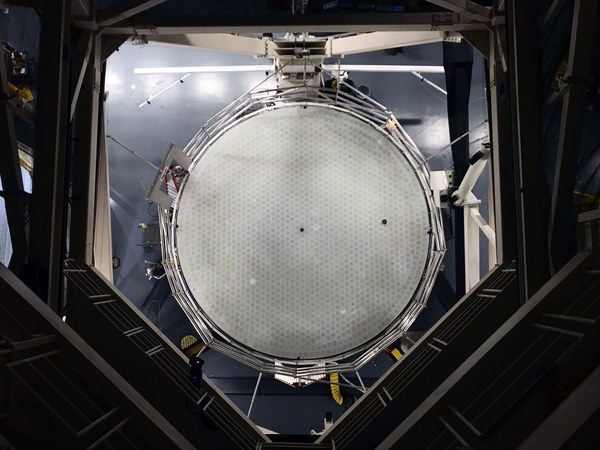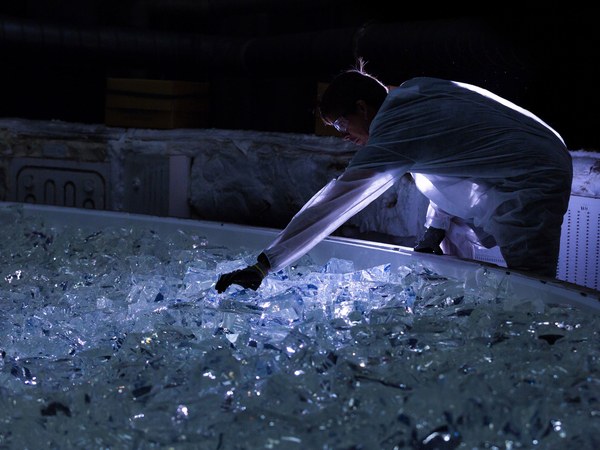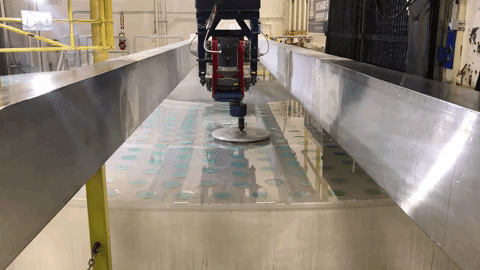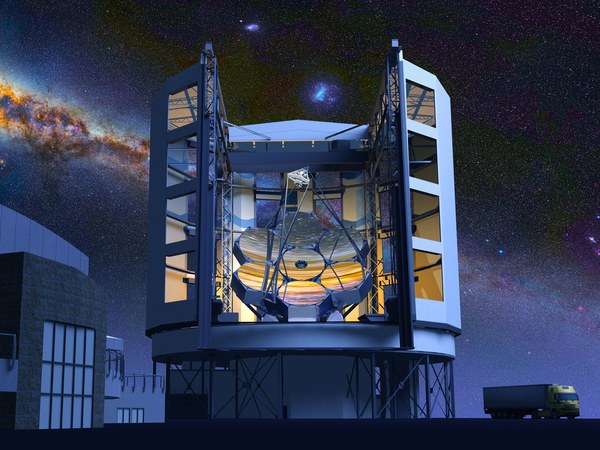Amazing engineering solutions for the largest optical telescope in the world

A member of the Mirror Lab places the last piece of glass in the shape for the fifth mirror for the Giant Magellan Telescope.
A glass factory at the University of Arizona is easy to miss. Although it is quite large, the lab mirrors it. Richard Caris is in the shadow of a much larger university stadium for American football with 56,000 seats. Even its most prominent feature — the octagonal elevation with the school’s logo — looks like part of the stadium's architecture. However, it is in this tower is the most important equipment of this factory.
In the Mirror Lab, a slightly glowing green staircase raises us five floors up to the entrance to the tower. I had not yet reached a few steps to the top, and the laboratory manager, Stuart Weinberg, asked for the third time if I had emptied my pockets completely.
“Points, keys, pens. Anything that could fall and damage the mirror, ”he says. Weinberger agreed to take me to the very top of the tower and further, to a narrow bridge located about 25 meters above a mirror with a diameter of 8 m. Six years have already been spent on making this mirror and $ 20 million. "Most people from the laboratory are not allowed here at all" - he says. This explains his nervousness about the contents of my pockets (and they are actually empty), and why he tied my camera to my wrist with a piece of paracord.

View of the second segment of the mirror from the top of the test tower of the Mirror Laboratory
The glass disk located beneath me is one of the seven mirrors from which the giant Magellan telescope will be made. When it starts operating at full capacity in 2025 at the Las Campanas Observatory in the Atacama Desert in Chile, GMT will become the largest optical observatory in the world. The mirrors, each weighing 17 tons, will be arranged in the form of a daisy, in which six asymmetrical mirrors surround the central, symmetrical segment. Together they will unfold to 25 meters (which is twice the diameter of existing optical telescopes) and will occupy an area of 370 sq. M. (like two tennis courts). The HMT, whose resolution will exceed that of the Hubble telescope 10 times, was created to capture and focus photons emitted by galaxies and black holes from the very borders of the Universe, study the formation of stars and worlds moving around them, and look for traces of life in the atmospheres of the planets located in the habitable zone.
But up to this point, scientists and engineers from the Mirror Laboratory need to make these colossal glass plates. And this, as you can guess, is a very monumental task.
“This is one of the most sophisticated mirrors ever made. They are off-axis, aspherical, large and extremely accurate, ”says Jeff Kingsley, assistant director of the Mirror Lab, after my descent from the tower. “Our goal is to develop a process in which the production of each mirror takes four years from start to finish.” It took almost ten years to make the first mirror. The second segment, which Weinberger put at risk of destruction on my part, began to be done in January 2012, and will not finish before 2019.

A mirror lab worker checks a mirror placed in the shape, selecting the space for the last few pieces.
In the Mirror Laboratory today there are four mirrors for the HMT at different stages of completion, and the complex process of manufacturing the latter begins just this week. The first step is to cast a mirror by loading 20 tons of borosilicate E6 glass [glass brand of the Ohara Corporation of Japan - approx. trans.] into a huge rotary kiln manually. Inside, there are 1,700 hexagonal columns of a mold in the form of combs, the construction of which took six months. Within a few days, the furnace warms up to 1,150 ° C and spins up to almost five revolutions per minute. Glass in liquid form flows into the space around the combs, and the rotation causes the thick liquid to flow to the edges of the mold, which gives the mirror its concave shape.
The oven returns to room temperature for three months. Only then can employees remove the mirror, put it vertically, and with the help of a temporary lift system, arrange a high-pressure bath for it. “We handle it with a car wash under pressure,” says Kingsley. “A student from the university’s mining department came to us and optimized it to clean the glass.”
After that, employees turn the mirror face down, put it on a large mobile device on an air cushion and transport it to the central hall of the factory, in which there are two polishing stations. On them, about half a centimeter of material is removed from the mirror from the back of the casting. After the mirror becomes smooth, employees fix 165 distributions of load on its rear part — the telescope’s actuators will be attached to them when the mirror is finally kneaded to work in the Atacama Desert.

Large optical generator removes imperfections from the back of the mirror
Then the staff turn the mirror face up - and the most difficult begins.
The six outer segments of the GMT mirror, the flower petals, have an asymmetrical shape. Their contours are topographically identical to the Pringles chips, although they are not curved so much. These curves can not be seen with the naked eye, but because of them, giving the desired shape to the mirror becomes an unreal headache.
“We need the telescope’s limitations to come down to fundamental physics — the wavelength of light, the diameter of the mirror — and not the imperfections of the surface of the mirrors,” says optics specialist Buddy Martin, who manages grinding and polishing in the laboratory. By imperfections, he understands defects greater than 20 nm — this roughly corresponds to the size of a small virus. But after casting the imperfections of the mirror can reach a millimeter and even more.

How, in the opinion of the artist, will look ready gt
A few passes of coarse machine grinding can reduce imperfections up to 20 micrometers - about a quarter of the thickness of a human hair. But these errors will be 1000 times more than what is required.
This is where the Mirror Lab tower comes into play. At its top, a set of lasers and interferometers, acting as a measuring tape for micrometer imperfections, is attached to the same forests that I walked through. The measurement process is so sensitive that the mirror must be located on the pneumatic system that compensates for the vibrations of the building. “Vibrations come from the football stadium, from traffic in the neighboring streets, from helicopters flying to the hospital,” says Martin. “They can't be felt, but the measurements are extremely sensitive.”
Sensors in the test tower create a contour map of the mirror surface. The map is loaded into polishing machines, which remove all hills. But not all at once. For more than a year, the mirror has been transported to and fro, between the test tower and polishing stations, until it becomes polished to the nearest millionth of a centimeter.
Only then can the mirror leave the laboratory. The first segment of GMT came out in September, making room for its relatives. Today, it is located in a temporary warehouse near Tucson International Airport, awaiting shipment to the Atacama Desert, where an 100-nm-thick aluminum coating will complete a long transformation of a 20-ton pile of glass pieces into a reflective surface, scanning space.
“You could even argue that we are not making mirrors here,” says Martin. “We only make large pieces of glass.”
All Articles